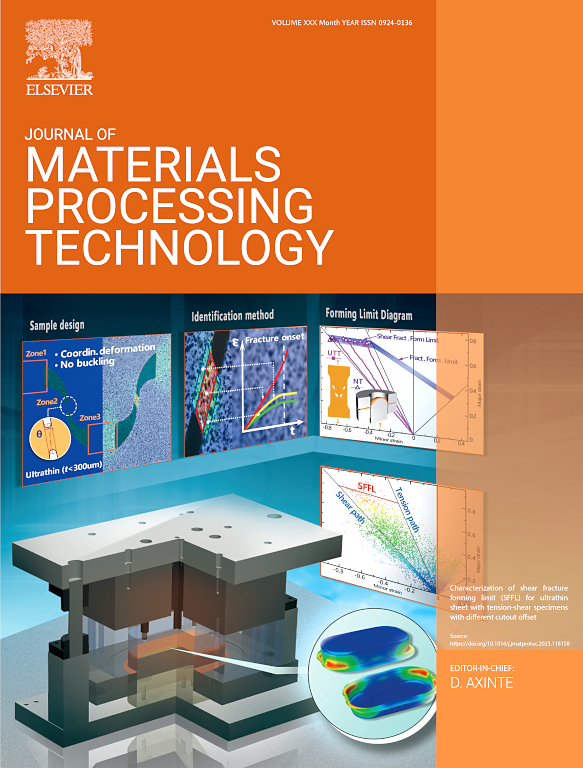SiCp/2009Al复合材料薄壁件铣削诱发的表层颗粒损伤与力学性能演化关系的机理研究
IF 6.7
2区 材料科学
Q1 ENGINEERING, INDUSTRIAL
Journal of Materials Processing Technology
Pub Date : 2025-06-06
DOI:10.1016/j.jmatprotec.2025.118932
引用次数: 0
摘要
SiC颗粒对于提高SiCp/Al复合材料及其薄壁件的刚度和强度至关重要。然而,铣削过程不可避免地会导致表层颗粒损伤,从而影响SiCp/Al薄壁件的性能。此外,建立铣削引起的颗粒损伤与力学性能演化之间的理论联系仍然是一个悬而未决的问题。为了解决这些问题,本文研究了不同铣削参数对不同颗粒含量和壁厚的SiCp/Al薄壁件表层颗粒损伤和力学性能的影响。结果表明:铣削导致SiCp/Al薄壁件的表层颗粒断裂、脱粘和基体开裂,削弱了SiCp/Al薄壁件的力学性能;破坏过程遵循颗粒脆性断裂和基体韧性断裂的协同承载机制。基于微力学理论,建立了考虑铣削颗粒损伤的SiCp/Al薄壁件有效模量和屈服强度预测模型。通过一系列力学性能试验验证了模型的准确性。此外,还研究了颗粒的应力和损伤概率以及不同强化机制的贡献。通过实验验证和理论分析,阐明了“工艺参数-表层颗粒损伤-力学性能演变”之间的内在联系。本研究为SiCp/Al薄壁件及其他颗粒增强复合材料的可靠性工程应用提供了新的视角和指导。本文章由计算机程序翻译,如有差异,请以英文原文为准。
Mechanistic insights into the link between milling-induced surface layer particle damage and mechanical property evolution of SiCp/2009Al composite thin-walled parts
SiC particles are crucial for enhancing the stiffness and strength of SiCp/Al composites and their thin-walled parts. However, the milling process inevitably induces surface layer particle damage, potentially impacting the performance of SiCp/Al thin-walled parts. Moreover, establishing a theoretical link between milling-induced particle damage and the evolution of mechanical properties remains an open problem. To address these challenges, this paper investigates the effects of different milling parameters on the surface layer particle damage and mechanical properties of SiCp/Al thin-walled parts with varying particle content and wall thickness. The results showed that milling led to surface layer particle fracture, debonding, and matrix cracking, which weakened the mechanical properties of SiCp/Al thin-walled parts. The failure process followed a synergistic load-bearing mechanism involving brittle fracture of particles and ductile fracture of the matrix. Furthermore, based on micromechanical theory, this study developed predictive models for the effective modulus and yield strength of SiCp/Al thin-walled parts, considering milling-induced particle damage. The model accuracy was verified through a series of mechanical property tests. Additionally, the stress and damage probability of particles and the contributions of different strengthening mechanisms were studied. The intrinsic link between "process parameters – surface layer particle damage – mechanical property evolution" was elucidated through experimental verification and theoretical analysis. This work provides new perspectives and guidance for the reliability engineering applications of SiCp/Al thin-walled parts and other particle-reinforced composites.
求助全文
通过发布文献求助,成功后即可免费获取论文全文。
去求助
来源期刊

Journal of Materials Processing Technology
工程技术-材料科学:综合
CiteScore
12.60
自引率
4.80%
发文量
403
审稿时长
29 days
期刊介绍:
The Journal of Materials Processing Technology covers the processing techniques used in manufacturing components from metals and other materials. The journal aims to publish full research papers of original, significant and rigorous work and so to contribute to increased production efficiency and improved component performance.
Areas of interest to the journal include:
• Casting, forming and machining
• Additive processing and joining technologies
• The evolution of material properties under the specific conditions met in manufacturing processes
• Surface engineering when it relates specifically to a manufacturing process
• Design and behavior of equipment and tools.
 求助内容:
求助内容: 应助结果提醒方式:
应助结果提醒方式:


